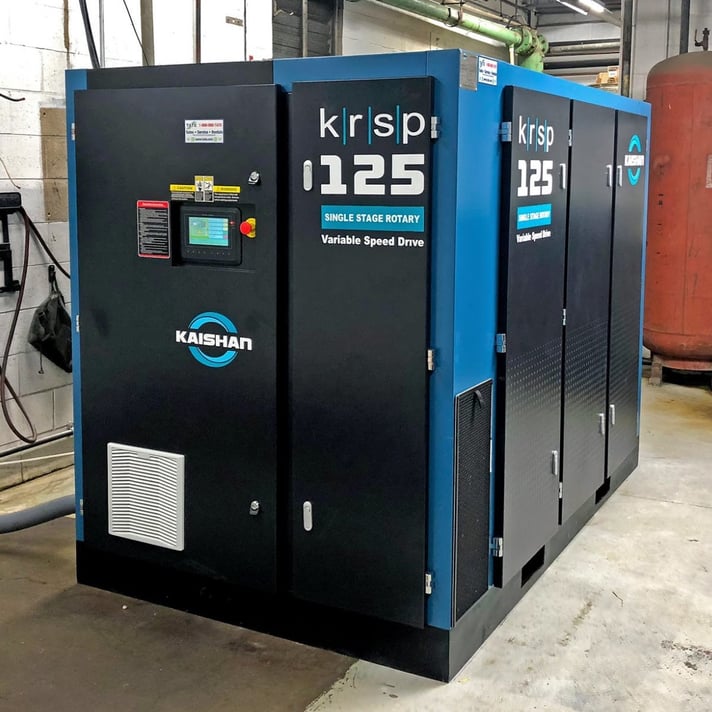
Air compressors have become ubiquitous in modern facilities and worksites as their efficiency and affordability has increased over the years. Air compressors work by converting energy from one form, such as electricity or diesel fuel, into potential energy in the form of pressurized air. This pressurized air is used for many different tasks, from cleaning and painting to powering tools. Compressed air removes the need for changing batteries, and changing tasks is as easy as swapping an air line to a new tool. Air tools are often lighter than battery-powered or corded power tools, which allows the operator to use them for longer periods of time without fatigue.
Because of the many different situations where compressed air can be useful, air compressors come in many different styles and variations. Each type of air compressor has its pros and cons, along with unique features. These features typically add to the cost of the air compressor, so their usefulness has to be weighed on a case-by-case basis. When selecting the right air compressor for your facility, it's important to make sure the capabilities of the compressor match the needs of the facility it serves.
Related: Summer Air Compressor Maintenance
No Replacement for Displacement
Air compressors can be broadly grouped into two categories: positive displacement and dynamic displacement. Positive displacement air compressors work by pulling air into a chamber and then reducing the volume of the chamber. This process causes the temperature and pressure of the air to increase. The most common varieties of positive displacement compressors are reciprocating and rotary screw type compressors. Dynamic displacement results in the same thing - pressurized air - but uses a different process to get there. Dynamic displacement sucks air into the compressor and accelerates that air. The high-speed air is then slowed down with a diffuser, causing the air pressure to increase. Axial and centrifugal air compressors are both examples of dynamic displacement compressors.
Reciprocating Compressors
Reciprocating compressors are the most common type of air compressor and can be found at businesses and construction sites all over the world. Similar to the motion of a combustion engine, reciprocating compressors use a piston inside a cylinder to mechanically compress air. Air is sucked into the cylinder and a motor then pushes the piston down, compressing the air. Due to the large number of moving parts, these air compressors must be lubricated with oil. Reciprocating air compressors are typically available in sizes up to 40HP. These air compressors are ideal for light to moderate duty shops. Some larger shops prefer to run multiple reciprocating compressors that feed compressed air into the same system. This technique provides redundancy in case a compressor fails. Some of the other major benefits of reciprocating air compressors are:
- Some of the cheapest air compressors on the market.
- Often easier to transport.
- Easy to install, service, and replace.
- Usually intended for stop/start intermittent duty cycle applications.
- Many different options and configurations are available.
Rotary Screw Compressors
Rotary screw compressors use two large screws rotating in opposite directions to compress air. Screw threads on the rotors trap air in pockets and compress the air as it is guided through the compressor. This compression generates a good bit of heat, but rotary screw compressors typically have built in cooling mechanisms. Rotary screw compressors typically have fewer moving parts and valves than reciprocating compressors, allowing them to last longer with less maintenance. These compressors typically fall in the 5HP to 350HP range. Rotary screw compressors are ideal for use in large facilities or large construction sites. Some of the biggest benefits of rotary screw compressors are:
- You can use them continuously due to internal cooling.
- They are available with oil-free options, which are ideal for clean air applications.
- Some models are available in air-cooled and water-cooled configurations.
- They require less maintenance than reciprocating compressors.
- Some models are available with variable frequency drive to allow for energy efficient part load operations.
Centrifugal Compressors
Because of their compact size and high speed of rotation, centrifugal compressors are able to produce large amounts of compressed air within a relatively small amount of space. Centrifugal compressors operate by using a fast rotating impeller to accelerate air and then slow it down in a diffuser to increase the pressure. These compressors can reach levels of horsepower of up to 1,000HP. Centrifugal compressors are great for large manufacturing facilities or chemical plants that require large amounts of compressed air. Some of the highlight of centrifugal compressors are:
- Oil-free options allow for clean compressed air.
- They are capable of operating continuously.
- They are capable of delivering massive quantities of compressed air.
Tate Engineering is proud to provide solutions for air compressors to our clients. If you’d like help finding the right compressor for your operations, or need help with maintenance, contact our professional staff today. We’ll be happy to help.
